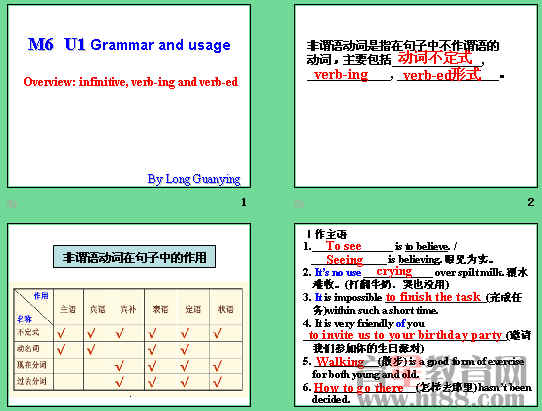《Laughter is good for you》ppt28
- 资源简介:

共21张,
Period4 U1 Book 6 Grammar and usage
Overview: infinitive, verb-ing and verb-ed
By Long Guanying from No.1 Middle School of Anren,Hunan
Teaching aims:
A.Get the students to review the forms of non-finite verbs
B.Get the students to summarise how to use them in different ways
C.Get the students to know the differences between different forms of non-finite verbs
Key points:
Get the students to tell the differences between different forms non-finite berbs
Difficult points:
Get the students to use the different forms of non-finite verbs correctly
Step 1.Different forms of non-finite verbs
非谓语动词是指在句子中不作谓语的动词,主要包括__________, _______, _________。
Step 2.Usages of non-finite verbs
Ⅰ作主语---先做练习
1._______________ is to believe. / ______________ is believing. 眼见为实。
2. It’s no use _____________ over spilt milk. 覆水难收。(打翻牛奶,哭也没用)
3. It is impossible ___________________(完成任务)within such a short time.
4. It is very friendly of you_______________________________(邀请我们参加你的生日派对)
5. ____________(散步) is a good form of exercise for both young and old.
6. ___________________(怎样去那里) hasn’t been decided.
再归纳:
1 不定式作主语常表示具体的某一动作;
动名词作主语表示泛指或一般的抽象概念
Swimming is exciting. / To swim in Lu River is terrible.
2.单个不定式作主语时,谓语动词用单数; 若不定式太长,往往用it作形式主语,真正主语不定式短语整体后置
3. 复合结构: It is /was + adj.+ (for /of sb.) to do sth.
eg: It is important for us to learn English well.
It is very kind of you to help me.
4. It is no use / no good / useless + doing sth
5.不定式可以和when / where /how /what /whether等连用,在句中作主语、宾语和表语
Ⅱ作定语---先做练习
1.He has no wish__________________(见她).
2.The power station ________________________明年修建的will be of great value to the people.
3.He is always the last __________________________ (离开公司).
4.The temple_________________________(矗立山顶的) was built in the Ming Dynasty.
5. The question_______________________ (正被讨论的)is important.
6.Last autumn, I took many photos of leaves __________________________(落到地上的).
7.I don’t like to see the letter ______________________ (用铅笔写的).
再归纳:
1在序数词、形容词最高级the first, the last, the only 等修饰的名词后用动词不定式作定语。
2. 若作定语的不定式是不及物动词, 或者及物动词与被修饰的词不能构成动宾关系时,则不定式动词后须加上适当的介词。




资源评论
共有 0位用户发表了评论 查看完整内容我要评价此资源